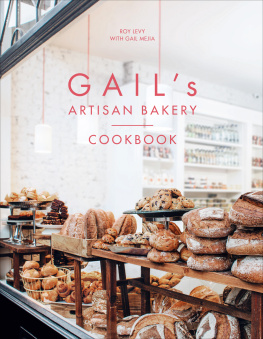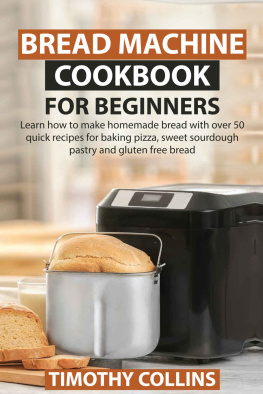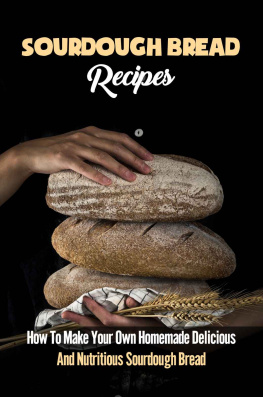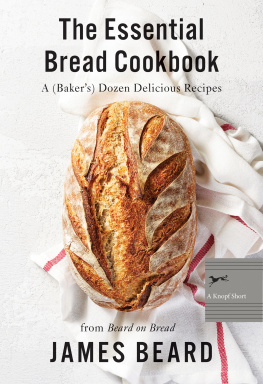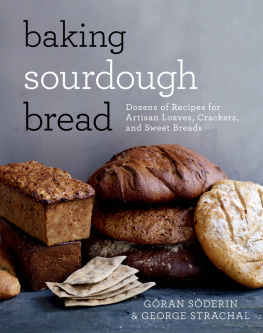CONTENTS
ABOUT THE BOOK
FOOLPROOF BAKING, GREAT BREADS AND DELICIOUS EVERYDAY MEALS FROM LONDONS ICONIC BAKERY.
GAILs shows you how simple it is to master delicious breads and use quality loaves to cook tasty, satisfying meals for breakfast, lunch, tea and supper. With the essential how-tos of kneading and shaping dough, inspired advice for perfecting pastry with ease, and bold, inventive recipes including Seeded Buttermilk and Treacle Loaf, Baked Bread and Chicken Soup, Sausage Rolls and Homemade Ketchup and Spiced Rum Punch Baba, GAILs abundant cookbook delivers over 100 brilliant savoury and sweet mealtime possibilities.
ABOUT THE AUTHOR
Roy Levy (Author)
The GAILs ARTISAN BAKERY story began in 2005, when founders Tom Molnar and Ran Avidan opened their first bakery in Hampstead to make world-class artisan bread more widely available beyond Londons top restaurants. They teamed up with Gail Mejia, founder of Baker & Spice, to form GAILs. Their aim was, and remains, to reinvent the way Londoners think about bread fresh and handmade and their neighbourhood bakery local and beautiful.
Thanks to our dear friend and co-founder Emma King, for working behind the scenes to make this book happen.
FOREWORD BY GAIL MEJIA
I cant bake to save my life! Not bread, not cake, not anything. I never could, and I doubt I ever will. Yet my ventures over the last twenty years in London revolved around bread and baking. At the outset buying, selling and distributing bread and other baked products, and later on opening Baker & Spice and then GAILs, each with baking at their heart. A life of baking in my head, and vicariously through the wonderfully talented people who worked with me and were able to interpret and bring to life some seriously mad notions. Baking, for me, has always been an intellectual exercise.
I love food but especially bread. Good simple food, with minimum fuss and even less ingredients, is happiness. I determined a long time ago that my last meal would be a slice of sourdough with French sweet butter and slices of ripe tomato sprinkled with sea salt.
I was already baking and distributing on a fair scale for the wholesale market in London when in 1995 an opportunity presented itself in the form of an old historical bakery and shop on Walton Street in London. The shop was tiny, a shoebox, but it had a substantial kitchen in the back with a bakery downstairs. Being rather impulsive I wanted to open a shop that would sell only what was made on the premises. That bakery downstairs was key to this idea, because down a rickety and wholly illegal wooden flight of stairs lay two monster ovens, possibly 150 years old, holding up the building above our heads. They were massive old flat-stone ovens and they worked.
It was scary and exciting and we set about trying to make bread as it was done 100 years earlier. It was at this precise point, reading bread recipes in books from around the world, that I discovered baking in my head. I could taste the bread in my mind as I was reading the recipes, and when we made some of them I knew with complete certainty what I wanted them to taste like.
Industrial food manufacturing I reasoned, is all about pretend food, making a mockery of what we are all forced to do, eat every day. I wanted to do it right and do it as well as we can. Good bread with a significant flavour profile takes time. Time is money. If you take time out of the equation you end up in Chorleywood, and the product most people consume in the UK. I call it the product because bread it isnt.
I was always interested in politics and dealing with food; buying for the business, making food and selling to the public brought with it a heightened sense of responsibility. People are actually eating what we cooked and baked; this had better be excellent in every sense. I cannot pretend to have arrived fully formed. I developed my theories as I went along. I am old enough to remember what good produce used to taste like before food became a global disaster, I knew about seasonality and geography, and got interested in sustainable and organic agriculture.
We fired up the flame-throwing monsters in the basement of what became Baker & Spice, and through trial and error and not following the rules because we didnt know them, out popped the most amazing bread. Mastering the art of baking with a sole oven is a process. You must befriend the beast and learn to recognize the hot spots and cooler climes in the chamber. We had our fair share of burnt offerings, under-bakes and all manner of disasters. We buried the failures and thought and baked our way into some absolute crackers, iconic examples that are still there, on the shelves of every GAILs shop to this day, nearly 20 years later.
I was bloody lucky with the people I worked with; Roy Levy being the ultimate soul mate. We elected to work mainly with sourdoughs and if you think that long slow fermentations are a leisurely affair you could not be more wrong. Sourdoughs, like people, are alive, temperamental and need constant care and supervision. My sourdoughs travelled the world and they are still going strong in GAILs bakery today, over 18 years later. This is the magic of the continuum, they were the heart and soul of the bread we made, and they still are.
Given the right conditions and training most people will actively choose to do well. Somehow, unspoken, we collectively decided that whatever we made we should always strive to create the best in class.
Several years had passed when one day I get a phone call from a stranger. Ran Avidan wanted to chat about an idea involving bread. Ran and his friend Tom Molnar had their own bread obsessions. They thought that London was poorly served with real quality bread and wanted to establish neighbourhood caf-bakeries. I loved the idea and we decided to work together to make this happen.
GAILs was born in Hampstead in June 2005. And she was beautiful. I designed a shop with a small bakery and kitchen in the back. We were bakers and we were going to bake in that shop daily. The window display, dominated by beautiful bread and pastries, left no doubts as to what we were about. Care was lavished on systems that ensured we never compromised the quality and integrity of what we made. I had great misgivings about putting my name above the door knowing full well that I would not be there forever but the quality continues under Roys sure hand and the dedication of a fantastic team of bakers who worked with me for so many years.
There is a strong thread linking my first shop and my last. In retrospect I realise that I developed my own food language. Notwithstanding the size of the business, bread is made the same way as when this journey began in Walton Street.
Despite the fact that until fairly recently most Londoners had no easy access to real bread, they recognised it when they saw it. I believe we are programmed with the love of bread in our DNA.
This book is about much more than bread. I hope, that the abiding idea everyone takes away from reading this book is how not to follow recipes. The thread that runs through it is that nobody will take care of our wellbeing more seriously than us.
Next page
